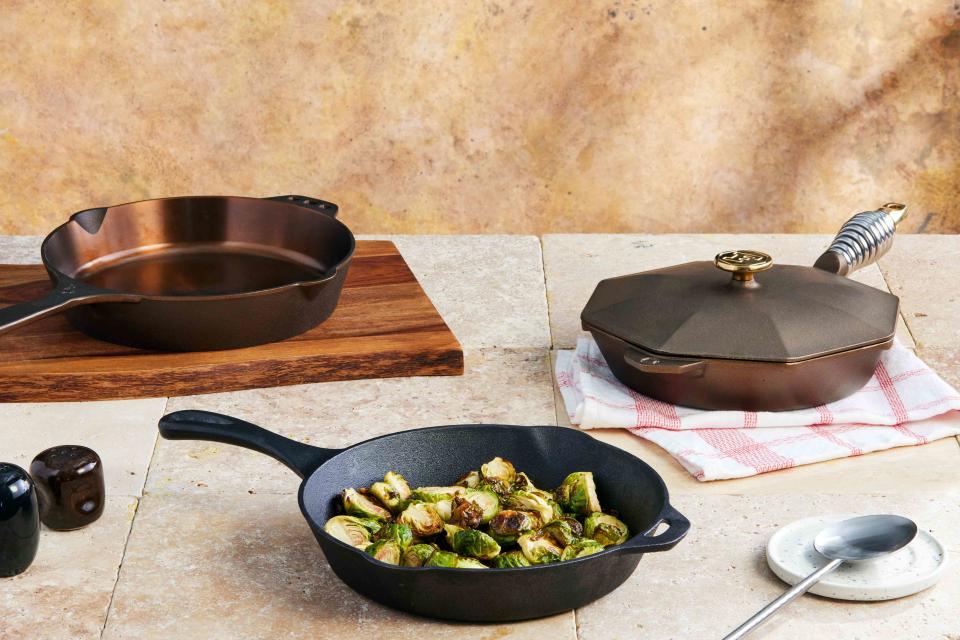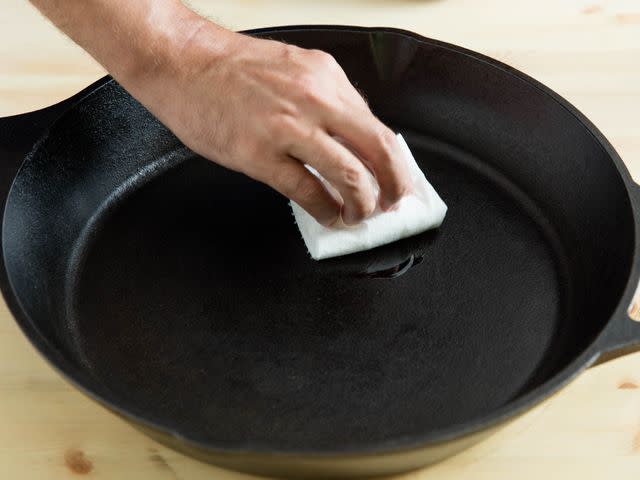Should You Buy a Cast Iron or an Enameled Cast Iron Skillet? Here’s a Comparison
Dotdash Meredith and Yahoo Inc. may earn commission or revenue on some items through the links below.
Both pans can sear the heck out of a steak—but which one is better?

Serious Eats / Russell Kilgore
While we think both pans are worthwhile, if you don't own either it's hard to beat the longevity and versatility of a traditional cast iron skillet like our favorite (after testing 22 pans!) from Lodge.
When you read the words “cast iron pan,” what’s the first image that comes to mind? A heavy black metal skillet with years of patina—a.k.a seasoning—built up into a glossy top coat? Or do you picture that pan with a smooth, naturally (somewhat) nonstick surface made from enamel? Maybe you imagine a 5-quart Dutch oven with a colorful exterior or a wide and shallow braising pan. All of these are made from cast iron (the exact composition of which varies with each manufacturer), and they are all excellent pans for a variety of cooking tasks.
Compared with stainless steel or nonstick, cast iron pans are heavy, durable, and great at heat retention. To efficiently evaluate the pros and cons of bare versus enameled cast iron (and help you decide which one is right for you), we’ll look primarily at skillets. Although you can find uncoated Dutch ovens and braisers, these shapes are most often coated in enamel—meaning the qualities inherent in enameled cast iron skillets apply to them, too (with exceptions relevant to size and shape).
Heat Conduction and Retention
Lodge Pre-Seasoned Cast Iron

Le Creuset Signature Enameled Cast Iron Skillet

Heat conduction (how efficient and quick a pan is at transferring heat from the cooking unit) and heat retention (how consistently the pan holds its desired temperature throughout the cooking process) are two different concepts. Because most cast iron pans are large and heavy, they are slower to heat and are inferior conductors of heat. But they shine at heat retention, maintaining a consistent temperature even when food is added.

Serious Eats / Taylor Murray
It's a myth that cast iron pans are superior at conducting heat. Instead, they're actually excellent at heat retention.The presence or absence of an enamel coating won’t affect either of these qualities. What does determine a pan’s efficiency in both categories is the type of metal used, as well as its thickness. As we've found in our reviews and use of both of these pan types, thinner, lighter-weight pans are faster to heat, and more prone to temperature fluctuations. Heavy pans with thick bottoms will excel in heat retention.
Performance

Serious Eats / Russell Kilgore
When we talk about a cast iron pan’s performance, we’re discussing its ability to sear as well as its potential for sticking. A high-performing pan with good heat retention will excel at a hard sear, creating a strong Maillard reaction that produces a golden-brown crust. The pan should also easily release the food from its surface, which happens once the reaction has been completed. So a pan with poor ability to sear is one that will cause food to stick or flake to its surface.

Serious Eats / Taylor Murray
When we tested enameled cast iron skillets, we seared a whole bunch of pork chops. You can see how the browned differently per pan here.Both enameled and bare pans are great at searing. The presence of an enamel coating may slightly hinder browning, though. As for the stick factor? When a bare cast iron pan is well-seasoned—meaning it’s coated in even, consistent layers of fat built up over time—it has natural nonstick capabilities. Note here we didn’t say it’s entirely nonstick. For delicate tasks, like cooking an omelet, we still recommend forgoing cast iron entirely and going with nonstick.
Versatility

Serious Eats / Taylor Murray
Kitchen folklore warns that it’s bad to cook acidic ingredients like tomatoes in a bare cast iron pan, because those foods may strip the iron from its surface, causing the pan to degrade. So you may think it would follow naturally that enameled pans are a better choice, due to their “all foods welcome” abilities. However, it’s debatable how much iron leaching actually happens with uncoated pans; a 2020 study showed the heat needs to be very high for this to occur. Stripping and corrosion also happen primarily when a pan is used without a layer of proper seasoning. And you wouldn’t use your bare cast iron pan without seasoning it, would you?

Serious Eats / Russell Kilgore
We think both traditional and enameled cast iron pans are exceptionally versatile.Our conclusion: with ample seasoning built up and an adequately hot temperature, uncoated pans are more versatile and nonstick than their enameled brethren. It's worth noting, too, that while traditional cast iron can be used at any temperature (literally, throw it over a fire!), enameled cast iron is more sensitive. One of our favorite enameled cast iron skillets, from Le Creuset, has a max temp of just 500°F—limiting some of its versatility.
Longevity

Serious Eats / Vicky Wasik
Here’s where bare cast iron absolutely takes the cake: These pans are built to last for generations. They’re incredibly durable, practically impossible to crack or break, and can even be brought back from the dead. It’s totally possible to revive a rusted cast iron pan at home, and if things get really bad, you can sand them back to a base layer, from where you’ll build up the seasoning over time.
Enameled cast iron pans are prone to chipping, cracking, and scratching over time, or with misuse. Metal utensils cannot be used on the enamel surface, so you’ll need to invest in silicone-tipped tongs and food turners if you plan on cooking with enameled pans. That said, high-end enameled pans like Le Creuset and Staub have excellent quality control to ensure proper construction. You’ll take your chances with cheaper coated pans.
Care and Maintenance

Serious Eats / Vicky Wasik
There’s no denying bare cast iron requires more meticulous care and maintenance than enameled cast iron. We don’t believe in babying cast iron—we’re totally fine with a little sudsy water—but it should never be left to soak or drip dry. Water is the enemy of exposed iron, so to properly maintain a bare pan, it should be washed, rinsed, dried, then heated with a thin layer of neutral oil to seal and protect the seasoning.
Read More:Le Creuset vs. Staub Dutch Ovens: The Battle of the Best
If that sounds too fussy, you’ll be happy to know you can soak, wash, and dry an enameled pan with almost as much cavalier abandon as you do other cookware. Just remember that it should not be introduced to metal, so use a bristle brush rather than steel wool for stuck-on food. Although some enameled cast iron pan manufacturers give the green light for dishwasher use, we still recommend washing it by hand to preserve the coating.
Price
| Cast Iron Type | Price |
Traditional | $25 | |
Enameled | $205 | |
Enameled | $200 |
Prices vary widely across all types of cast iron pans. Overwhelmingly, high-end, high-cost enameled cast iron pans are made with tight quality control (and often at onsite-factories), which drives up the price.
When it comes to traditional cast iron though, save your cash. As we found in our cast iron skillet review revealed, some cheaper pans—like our favorite from Lodge—performed just as well (and often better) than expensive ones.
FAQs
What is the best cast iron pan?
In our review of bare (uncoated) cast iron skillets, we named two winners for superior performance. The best all-around, everyday cast iron pan is Lodge’s Pre Seasoned Cast Iron Skillet. It’s also one of the more affordable pans at just $20. For a lighter-weight, sleeker option, we liked the slightly pricier Blacklock pan from Lodge.
What is the best enameled cast iron pan?
Our review of enameled cast iron skillets named three winners. Staub’s 10-inch skillet is efficiently light with generously sloping sides, and a dark enameled interior that resists staining. Our second pick, from Le Creuset, performed similarly, although weighed slightly more and is a quarter-inch larger. We recommend Crock Pot’s cast iron skillet for a budget buy, although it struggled a bit in the nonstick and cleaning tests.
How do you wash a cast iron pan?
It’s easy. Just lather it up with hot, soapy water and a non-scratch sponge, then rinse the pan clean. The layers of seasoning have been polymerized, meaning they won’t rub off with basic soap and water. After that, use a dish towel to dry it completely. Rub it down with a neutral oil, like vegetable or corn oil, and heat it on the stovetop for a couple of minutes. That’s it! Specialty scrubbers, like chainmail “cloths” are an option, although they may contribute to stripping and rusting over time.
Read More:We Tested 22 Cast Iron Skillets—Here Are the Best Ones

